Vol1 No30
Table of Contents
Assist Feeding – Emergency Rations
Feline Nutrition – …From Last Week
Pro-Active Cat Care – Kittens ‘n’ Katz
Feline Obesity – I’m Losing Weight Mom!
Kitty Potpourri – Breed Profile: The Scottish Fold!
Assist Feeding – Emergency Rations
by Kathy Fatheree
As many of you know, I’ve been struggling with the kitty cold around here. but good news. We have won this round! Maya started eating on her own last Thursday and Miss Picasso was back to eating on Friday. What a relief! It was a very stressful week and I had to finger feed Miss P for 6 entire days. she suffered the most from this cold and was barely able to breathe much less eat or drink water on her own. When I finger fed her at first, she almost panicked because she could not breath.
Looking back over the last few weeks, I realize that I was very lucky to have many of the supplies I needed on hand. This week though, I noticed that I was entirely out of canned food and I wouldn’t be prepared if this cold snuck up on us again without warning like it did last time. Things like this usually happen on the weekend so I decided I needed to build a little emergency kit.
Today I swung buy the vets as asked if I could buy 6 more cans of Hill’s a/d just to keep on hand in case one of the kitties came down with a cold again.
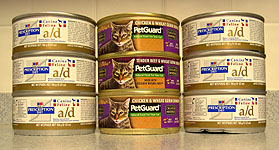
To my surprise, they said “Sure!” Since Miss P had just been treated, they felt comfortable selling me more of this prescription food. If you want to build a little emergency kit, choose a food that you know you can either finger feed or syringe feed. You many need to buy several different foods, open them up and determine if they are suitable to go into your emergency kit. You don’t want to be alone in the middle of the night on a weekend and open a can to find that it’s just too dry, or too chunky or too anything that you cannot feed successfully. Better yet, find your emergency food and try it out on your kitty a few times to see if you will be successful. Then you can add 6 cans to your emergency kit.
Note: Hill’s a/d is high fat and high protein so you will need to talk to your vet and select a food that is right for your kitty.
When I took Miss P to the emergency vet last Sunday, they sold me the a/d food, but they didn’t say anything about water. I didn’t think about this until we were on the way home, so as soon as I got home, I weighed her on my shipping scale that is accurate to 0.2 pounds and she had lost 0.8 pounds. that had to be all water weight! A sick cat may quickly become dehydrated because of not eating and not drinking.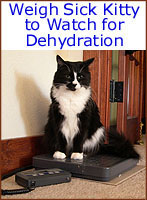 Luckily I happened to have a 3ml syringe on hand and I could handle it quite easily to give her some water. I filled the syringe with water then gently squeezed a little into the side of her mouth taking care not to squeeze too much and I also took care not to allow it to go down the wrong pipe. I gave her a little water, allowed her to swallow, then allowed her to take several breaths since her nose was so stopped up, then repeated. I was able to get 9ml of water in her 3 to 4 times a day. Buy several syringes from your vet
Luckily I happened to have a 3ml syringe on hand and I could handle it quite easily to give her some water. I filled the syringe with water then gently squeezed a little into the side of her mouth taking care not to squeeze too much and I also took care not to allow it to go down the wrong pipe. I gave her a little water, allowed her to swallow, then allowed her to take several breaths since her nose was so stopped up, then repeated. I was able to get 9ml of water in her 3 to 4 times a day. Buy several syringes from your vet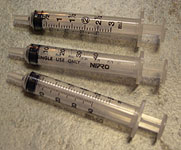 and keep them in your emergency kit. Water via the mouth (vs. SubQ fluids) is very helpful in hydration, digesting food and preventing constipation so I highly recommend it. The 1st time I gave Miss P several syringes of water after a feeding, her stomach gurgled as everything settled into place. she really needed the water.
and keep them in your emergency kit. Water via the mouth (vs. SubQ fluids) is very helpful in hydration, digesting food and preventing constipation so I highly recommend it. The 1st time I gave Miss P several syringes of water after a feeding, her stomach gurgled as everything settled into place. she really needed the water.
So buy some emergency rations to have on hand for your kitty. It’s better to have them on hand and never need them than to find yourself all alone wishing for supplies.
Feline Nutrition – From Last Week
by Garry White
I’d like to spend a little more time on last week’s discussion about pure (holistic) foods. Mind you, I’m not one who believes in exclusivity; there are times when we have to bend our “firm” rules. Such is the case with feeding our kitties. While I’m pretty well settled into the concept of quality nutrition for my guys, sometimes they get a can of the store stuff that’s loaded with everything wrong. Well, shoot; sometimes I put extra butter on my garlic bread, because it tastes better with that fat, juicy Ribeye steak. Fair is fair. Besides, we all know that a regular diet of the wrong stuff is harmful, but an occasional treat is probably harmless. So that’s the path I follow.
Mostly, my fellows are eating a holistic food now, and I want to share with you the results I’m seeing from that change. First of all, I was enlightened to the fact that it takes about 3 months to see the effects of any diet change. Secondly, I’m not bragging: I know too well how quickly a kitty’s situation can change, and I’m just grateful for every moment that things seem to be going well. But they surely do seem to be going well. As things stand, I cannot say enough good things about what I’m seeing.
Their eating habits have changed, for one thing. Apparently this food is satisfying them more, because neither of them guzzle food now. They nibble throughout the day, but nobody sits there at the bowl for any length of time. The benefits of this? Clark has had a paunch for the past several years. He’s not fat, but he had that paunch hanging down that swung from side-to-side when he walked.he’s not losing weight, but that paunch is disappearing! I have to assume it’s because he’s eating less and eating better food. He’s also far more active than he has been in years! The pros say “kitten food for kittens”, but Wilbur gets the same food, and he’s as sleek and firm as a show-cat. Their coats -both of them – look as though they get special grooming, but they don’t. Again, I attribute this to diet, because it’s the only change.
Also, Clark (who is the consummate dry-food-only cat) has taken a liking for his canned food treats, and even sits in that feeding area now, begging for a bit of it!
I guess my conclusion is that the pure foods really do make a difference. We have to allow time for their systems to adapt and adjust, but I’m seeing nothing but positive results from this effort. And quite honestly, it’s as close to a zero-maintenance feeding program as I could imagine. One can only guess at what’s around the next bend, and Clarkie boy is an older cat.but as of this moment, he seems healthier than I’ve seen him in many years. Is the diet responsible for this? With no other changes in his lifestyle, I have to assume so.
ProActive Cat Care – Kittens ‘n’ Katz
by Garry White
Perhaps some –or even most– of you have introduced kittens into a household where bona fide cats have maintained status as the resident critters. Up until Dear Wilbur, I had not, and I tell you it’s an experience. An education, I should say. My first blusterous chant was that we are not going to modify the household to fit the kitten; the kitten will have to learn how we already do things, and adapt to our happy existence. Straighten up your act, cat, or you’ll be sharing space with farm animals! However, I once told a beefy lumberjack fellow that I was gonna knock his head off, and I suppose it’s noteworthy that Wilbur and the lumberjack showed equal fear of my tirade.ZIP!
So it seems that Wilbur is here to stay, and given that assumption, I have begun to look at thing from a different angle. Obviously, my first concern was/is for Clark, who has been up and down the ladder with me for a very long time. The kitten is new, and my allegiance is to Clark, period. But the kitten, I’ve discovered, is not quite the “burden” I felt initially: He brings much to this wacky household, and especially to Clark. Mind you, I was torn on this issue for a time, and I still suffer a bit of confusion occasionally. Wilbur, you see, loves getting Clark to put on his “hiss-snarl-growl-swat” show, but I’ve noticed something of late: It seems to happen mostly when I’m present! I can be gone for a while, return, and both of the little darlings are sound asleep hither and yon. Minutes later, they’re at it.WAR! Or so it seems. But leave them alone for a while, go peek when I’m not supposed to be peeking, and there’s Clark on top of a box or table, Wilbur on the floor.one reaching up and one reaching down, batting paws. Clearly playing. I make my presence known, and it’s instant war. What’s the deal? Is Wilbur trying to show me that he knows his role is to play with Clark? Is Clark, for some reason, feeling guilty that I might think he actually likes that kitten? He does, there’s no doubt: If I scold Wilbur, Clark is right there fussing at me.
So I defer to some of you old-timers with multi-cat households, because I’m at a total loss. The bottom line is that they’re both performing for me. But I can’t figure out why. I’d like to do an article or two on just this topic, because it’s great information for all of us, and I doubt that I’m the first one to encounter it. I was seriously considering that maybe Clark needed a “milder” companion (because of Wilbur’s constant bugging), but in looking behind the scenes, I think I’m wrong; I think Clark would be heartbroken.
Feline Obesity – I’m Losing Weight Mom!
by Kathy Fatheree
It’s been an ongoing struggle to help Phoebe lose weight! We have tried so many different foods and we have finally found one that both she AND her body like. She is absorbing the nutrition AND losing weight!!! She has lost a little over a ½ of a pound these last 30 days and we are both so happy!
Now you may not think ½ pound sounds like much, but we have been trying to lose weight since January and this is the first little budge! I can tell that Phoebe feels lighter! She is actually jumping up on my bed again to sleep with me each night. and the other day she was in a frisky mood and did this little jump in the air! Not an easy thing for a 19.2-pound cat to do!
A ½ of a pound on Phoebe is like if I lost about 3 ½ pounds. I know I could tell if I lost 3 ½ pounds. I may not be leaping into the air, but I know my jeans would be a lot more comfortable!
Now that Phoebe has lost a little, it encourages me to work even harder with her. I meal feed her 3 times a day.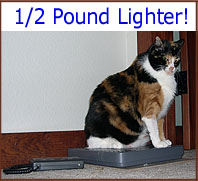 I feed her in the morning before I go to work. I feed her when I get home. I feed her a little before we go to bed. All the other cats eat at these 3 times as well. Each kitty has their own feeding station and they do quite well with this. As I’m getting ready for work, I keep an eye on each cat to make sure they aren’t snitching from another kitty’s bowl. To be successful with this, I make sure that they all sit at least 5 feet from each other at a minimum. They more often than not, sit at the same spot each day to eat. They actually picked their own feeding spots. Phoebe has learned to eat her food and only her food so I really don’t have to correct her much. well actually. I never have to correct her now that she has learned the routine. She is really smart and a good girl. Well.she has jumped up on the bathroom counter when I accidentally left food out and she gorged on that, but she doesn’t really snitch from the other cats. Most cats can be trained when they are worked with on a consistent basis, so give it a try… you might be surprised!
I feed her in the morning before I go to work. I feed her when I get home. I feed her a little before we go to bed. All the other cats eat at these 3 times as well. Each kitty has their own feeding station and they do quite well with this. As I’m getting ready for work, I keep an eye on each cat to make sure they aren’t snitching from another kitty’s bowl. To be successful with this, I make sure that they all sit at least 5 feet from each other at a minimum. They more often than not, sit at the same spot each day to eat. They actually picked their own feeding spots. Phoebe has learned to eat her food and only her food so I really don’t have to correct her much. well actually. I never have to correct her now that she has learned the routine. She is really smart and a good girl. Well.she has jumped up on the bathroom counter when I accidentally left food out and she gorged on that, but she doesn’t really snitch from the other cats. Most cats can be trained when they are worked with on a consistent basis, so give it a try… you might be surprised!
I’ll report in on Phoebe’s weight loss progress again next month. Wish us luck!!
Kitty Potpourri – Breed Profile: The Scottish Fold!
by Dan Malenski
This week we will talk about a breed that may not be the most popular, but without question, one of the cutest, that is, the Scottish Fold. After you see their photos, you may think that they were bred by us humans to be “designer cats”, but that is not so. The Scottish Fold originated from a natural occurrence, and the scientific community agrees that their hallmark of folded ears is the result of a spontaneous mutation of a dominant gene. The first Scottish Fold, as we know them today, was discovered on a farm in Scotland in 1961. The cat was a white barn cat by the name of Susie. Other than their folded ears, they possess huge round eyes, which quickly capture the hearts of those who gaze upon them.
The Scottish Fold is a medium size cat that ranges from 9 to 13 pounds in the male and 6 to 9 pounds in the female. The body is generally well rounded with a head attached by a very short neck. 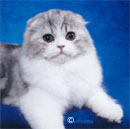 The eyes are large, round, and convey a sweet expression to all. The curve of the mouth around their large whisker pads gives one the impression that they are always smiling. The coat could be either short or medium longhaired and can come in all colors possible. The fold of the ears can be in various degrees, designated as single, double, and triple fold.
The eyes are large, round, and convey a sweet expression to all. The curve of the mouth around their large whisker pads gives one the impression that they are always smiling. The coat could be either short or medium longhaired and can come in all colors possible. The fold of the ears can be in various degrees, designated as single, double, and triple fold. 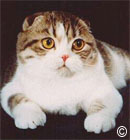 The single fold is somewhat of a “loose” fold where the triple fold is when the ear is tight to the head. In all cases, the ears are of medium size and rounded at the tips. At the time of birth, all kittens will have straight ears, and it is not until they are about three weeks old when one will be able to tell if it will have folded ears or not.
The single fold is somewhat of a “loose” fold where the triple fold is when the ear is tight to the head. In all cases, the ears are of medium size and rounded at the tips. At the time of birth, all kittens will have straight ears, and it is not until they are about three weeks old when one will be able to tell if it will have folded ears or not.
Although it appears contradictory, the Scottish Fold could have straight ears and still be a Scottish Fold! Here is where I ran into trouble with the girls, specifically Amanda, who didn’t understand why a Scottish Fold with straight ears is still considered a genuine Scottish Fold. I didn’t want to get into this, but having been “pinned down” by a twelve-pound silver tabby (Amanda), I was forced to explain. I had to explain to her that the fold in the ears is the result of a gene mutation called a simple dominant. This means that if an offspring inherits a straight ear gene from one parent and a folded ear gene from the other, its ears will be folded. Any other combination will result in straight ears. Regardless of the state of the ears, their other characteristics, including temperament will be identical. This information and that for the remainder of this article was obtained from several internet sources.
The Folds are gentle, sweet, and quiet cats with voices that are soft, chirpy, and not often used. If you are looking for a cat that is active, noisy, and for the most part wants nothing to do with you, then the Fold is not for you. The Fold will always want to know what you are doing and craves attention. Scottish Folds should not be left alone for long periods due to their need for companionship. If one must be away from home for many hours at a time, a playmate may be in order, and need not necessarily be another Scottish Fold.
The Fold is generally a cat with no outstanding medical concerns except one that could be brought to the surface by their manner of breeding. Most ethical breeders will only breed straight-eared cats to folded-eared cats in order to avoid a particular degenerative joint disease. Cats bred in this manner seldom develop this disease. If this disease should develop, however, it is not life threatening and treatable.
Now, if you now decide that you must have a Scottish Fold, you may need to contact a breeder, but before doing so, be sure to check out http://www.petfinder.com or any one of many Scottish Fold rescue groups on the internet to determine if there are any of these charming creatures in a shelter near you. Although the Scottish Fold is somewhat rare in the feline population, at the time of this article, there were 26 Scottish Folds or mixes looking for good homes in petfinder.com alone! If you don’t have one near you, there are several methods available for transporting cats over longer distances.
Disclaimer: Kathy Fatheree is not at all a medical expert. Contents of this web site are a collection of Kathy’s assist feeding experiences as well as the experiences of other cat owners who have assist fed their cats. While every effort has been made to ensure the accuracy of the information, Kathy Fatheree or anyone associated with this web site cannot be held responsible for anything that may happen as a result of using the information on this site.
